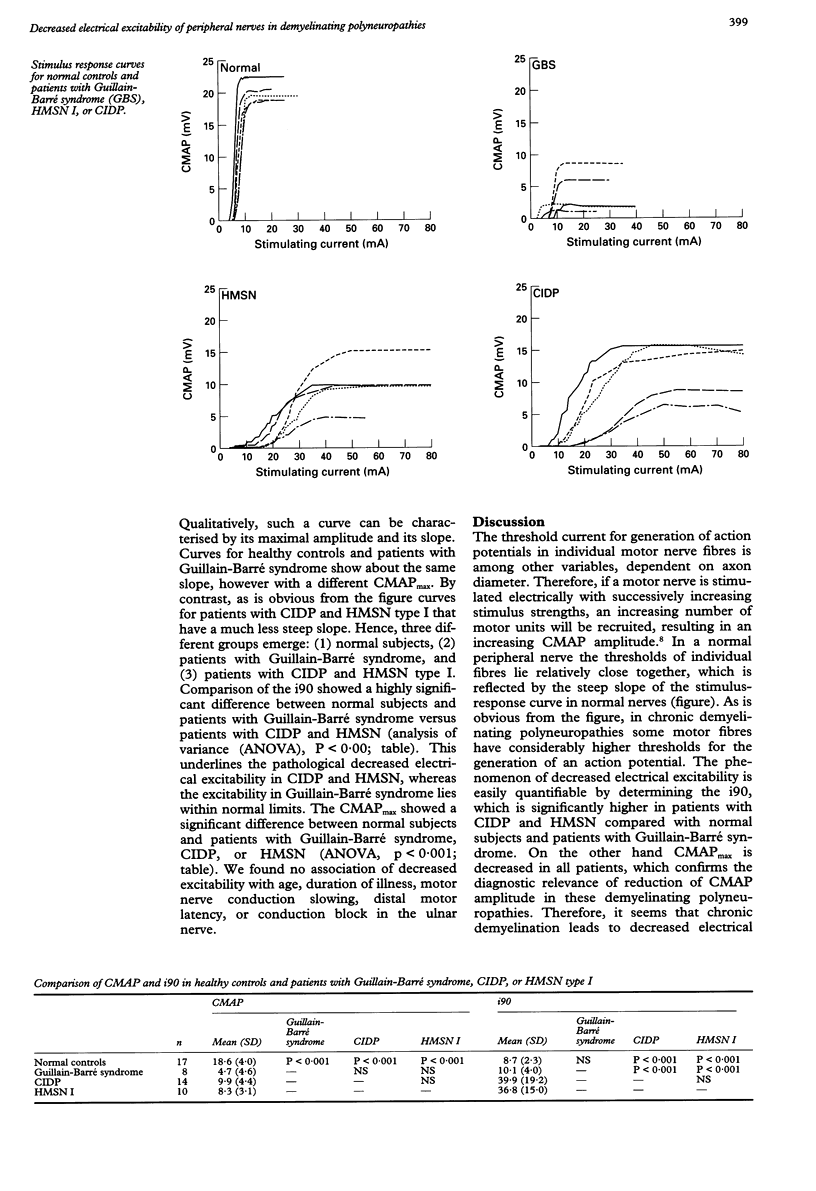Abstract
Not recognising the presence of decreased excitability may give rise to a seemingly low compound muscle action potential, which may lead erroneously to the conclusion of conduction block. To quantify decreased electrical excitability, stimulation-response curves and the current needed to achieve 90% of the maximal compound muscle action potential amplitude, i90, were obtained in 17 healthy controls, eight patients with Guillain-Barre syndrome, 14 with chronic inflammatory demyelinating polyneuropathy, and 10 with hereditary motor sensory neuropathy type I. Decreased electrical excitability was found in patients with chronic inflammatory demyelinating polyneuropathy and hereditary motor sensory neuropathy type I, by contrast with patients with Guillain-Barré syndrome. Recognising decreased excitability prevents the false assertion of conduction block and has electrodiagnostic importance for the differential diagnosis of demyelinating polyneuropathies.
Full text
PDF


Selected References
These references are in PubMed. This may not be the complete list of references from this article.
- Asbury A. K., Cornblath D. R. Assessment of current diagnostic criteria for Guillain-Barré syndrome. Ann Neurol. 1990;27 (Suppl):S21–S24. doi: 10.1002/ana.410270707. [DOI] [PubMed] [Google Scholar]
- Brismar T. Changes in electrical threshold in human peripheral neuropathy. J Neurol Sci. 1985 May;68(2-3):215–223. doi: 10.1016/0022-510x(85)90102-9. [DOI] [PubMed] [Google Scholar]
- Gabreëls-Festen A. A., Gabreëls F. J., Jennekens F. G. Hereditary motor and sensory neuropathies. Present status of types I, II and III. Clin Neurol Neurosurg. 1993 Jun;95(2):93–107. doi: 10.1016/0303-8467(93)90002-x. [DOI] [PubMed] [Google Scholar]
- Hoogendijk J. E., de Visser M., Bour L. J., Jennekens F. G., Ongerboer B. W. Conduction block in hereditary motor and sensory neuropathy type I. Muscle Nerve. 1992 Apr;15(4):520–523. [PubMed] [Google Scholar]
- Kaku D. A., Parry G. J., Malamut R., Lupski J. R., Garcia C. A. Uniform slowing of conduction velocities in Charcot-Marie-Tooth polyneuropathy type 1. Neurology. 1993 Dec;43(12):2664–2667. doi: 10.1212/wnl.43.12.2664. [DOI] [PubMed] [Google Scholar]
- Meulstee J., van der Meché F. G. Electrodiagnostic criteria for polyneuropathy and demyelination: application in 135 patients with Guillain-Barré syndrome. Dutch Guillain-Barré Study Group. J Neurol Neurosurg Psychiatry. 1995 Nov;59(5):482–486. doi: 10.1136/jnnp.59.5.482. [DOI] [PMC free article] [PubMed] [Google Scholar]
- Veltink P. H., Van Alsté J. A., Boom H. B. Influences of stimulation conditions on recruitment of myelinated nerve fibers: a model study. IEEE Trans Biomed Eng. 1988 Nov;35(11):917–924. doi: 10.1109/10.8671. [DOI] [PubMed] [Google Scholar]
- van Doorn P. A., Brand A., Strengers P. F., Meulstee J., Vermeulen M. High-dose intravenous immunoglobulin treatment in chronic inflammatory demyelinating polyneuropathy: a double-blind, placebo-controlled, crossover study. Neurology. 1990 Feb;40(2):209–212. doi: 10.1212/wnl.40.2.209. [DOI] [PubMed] [Google Scholar]
- van der Meché F. G., Vermeulen M., Busch H. F. Chronic inflammatory demyelinating polyneuropathy. Conduction failure before and during immunoglobulin or plasma therapy. Brain. 1989 Dec;112(Pt 6):1563–1571. doi: 10.1093/brain/112.6.1563. [DOI] [PubMed] [Google Scholar]


